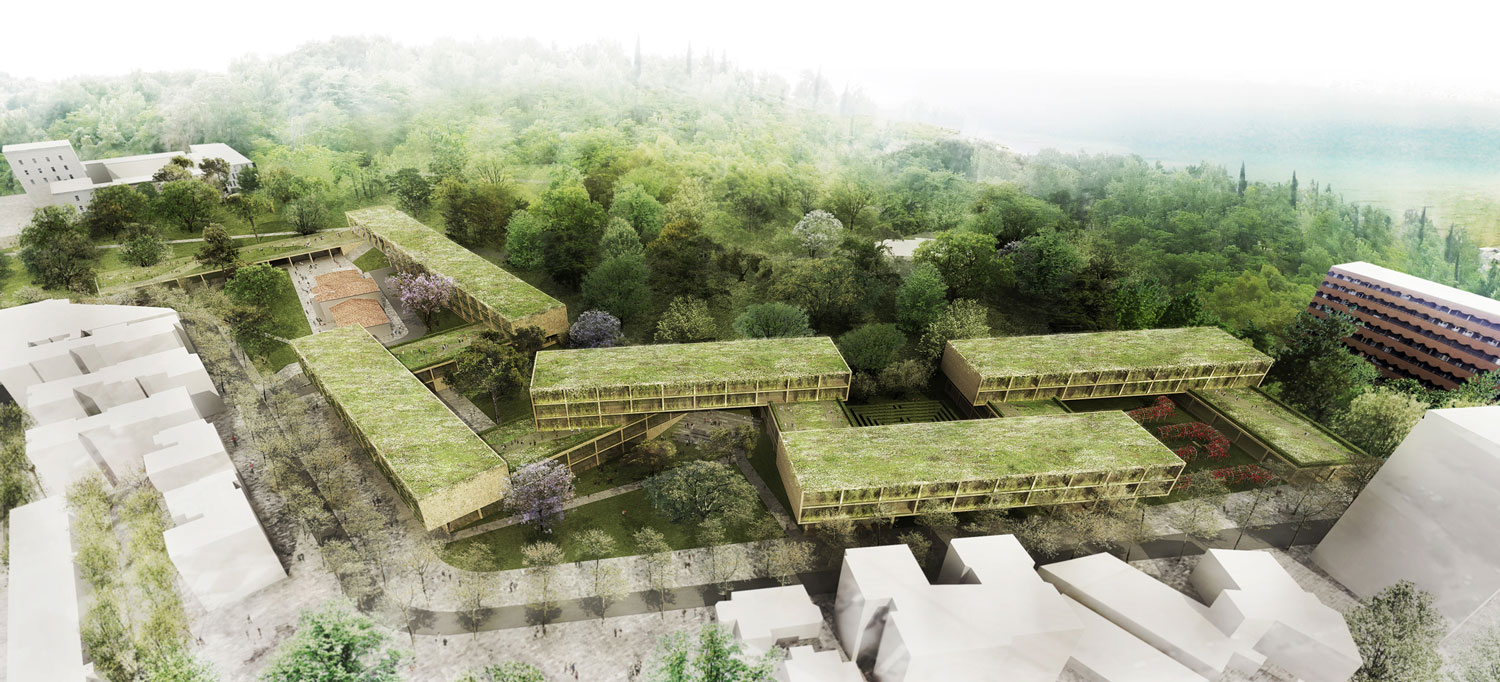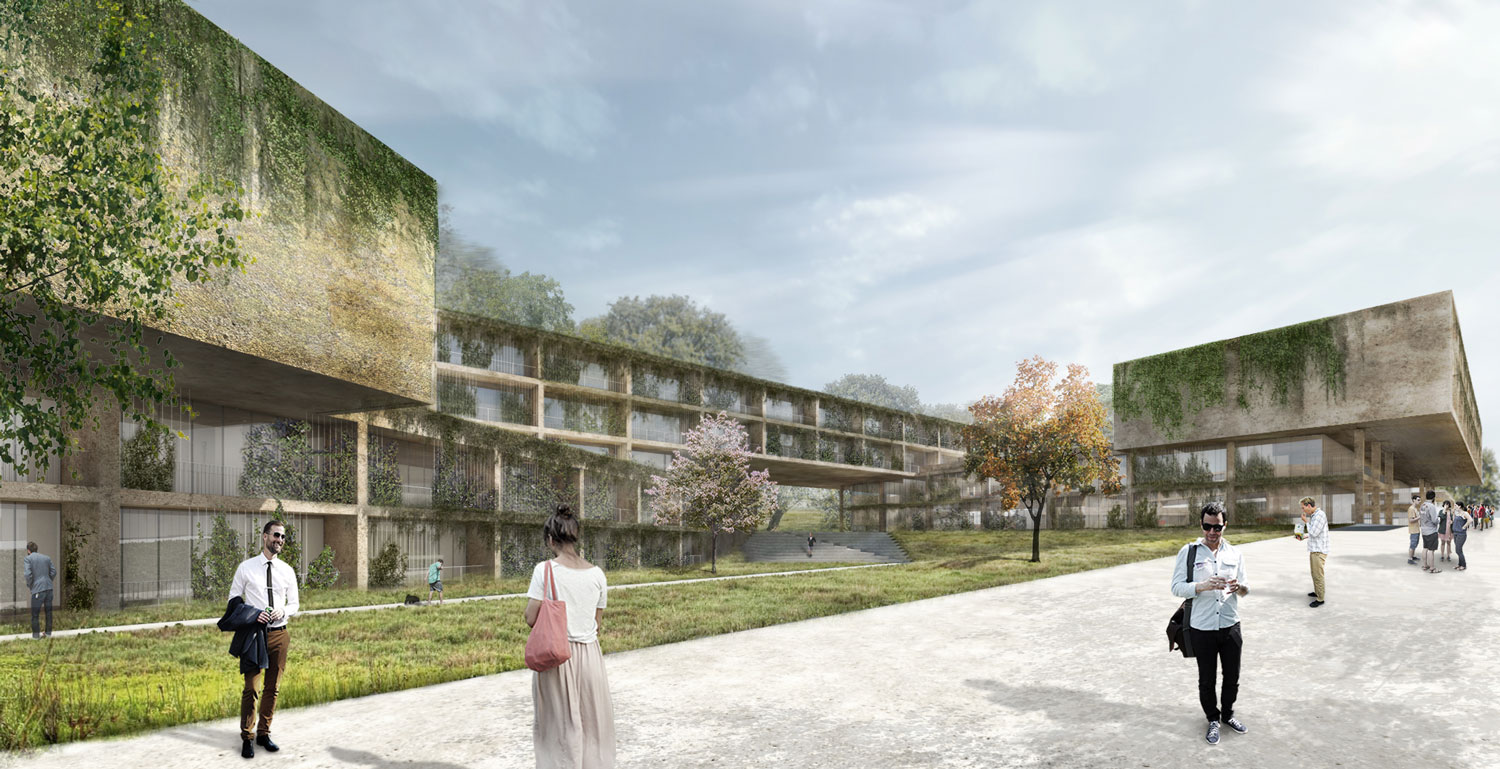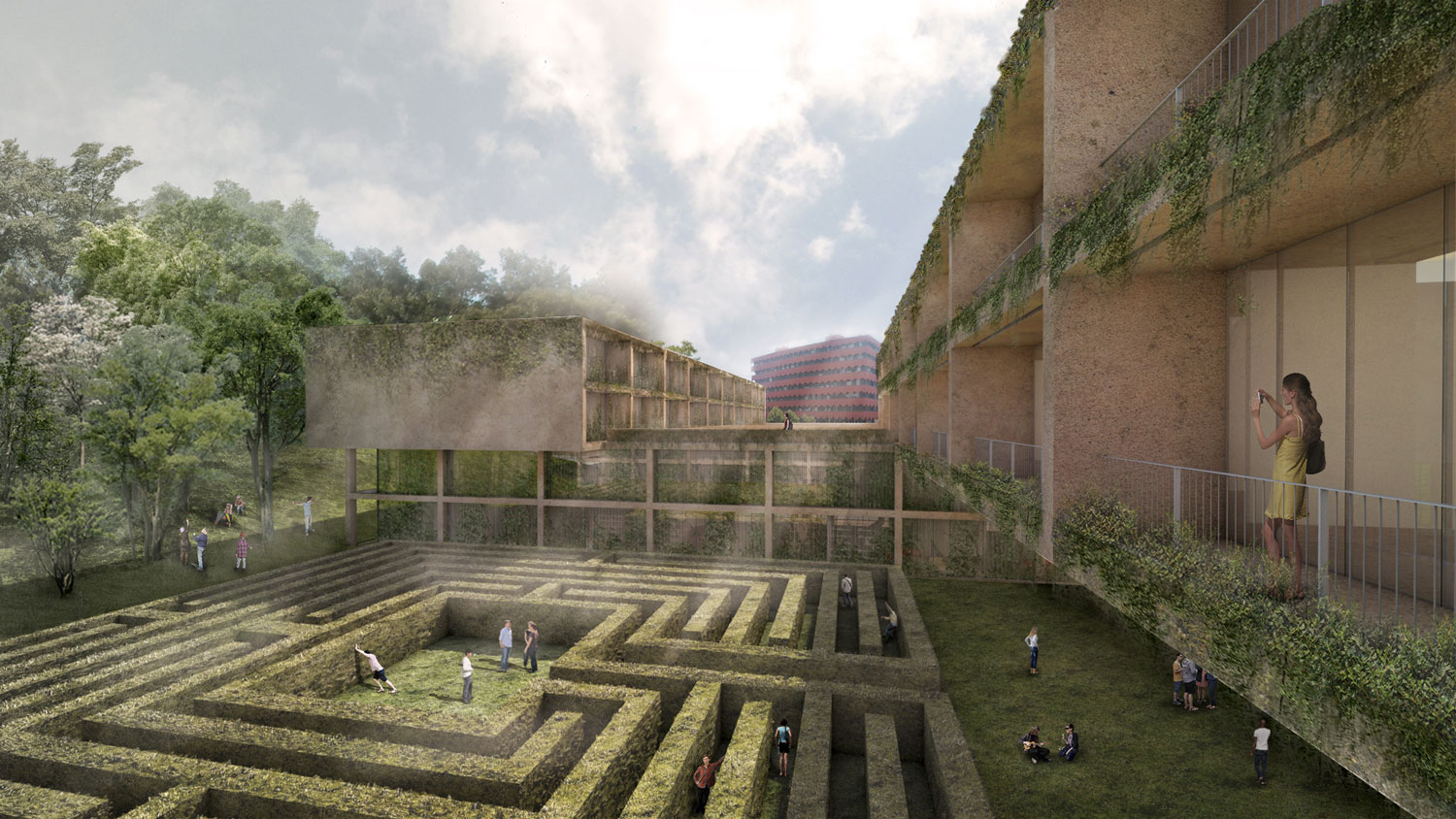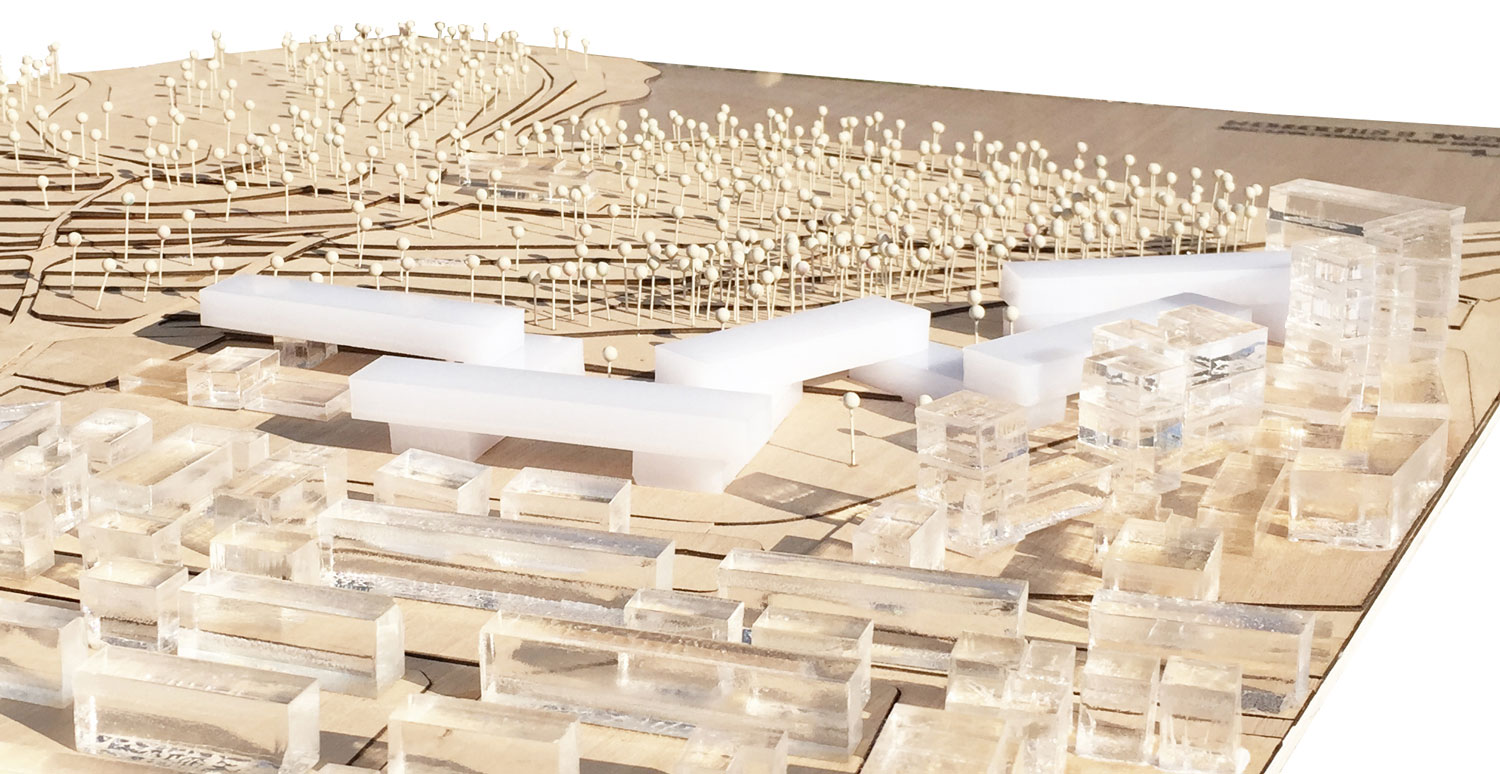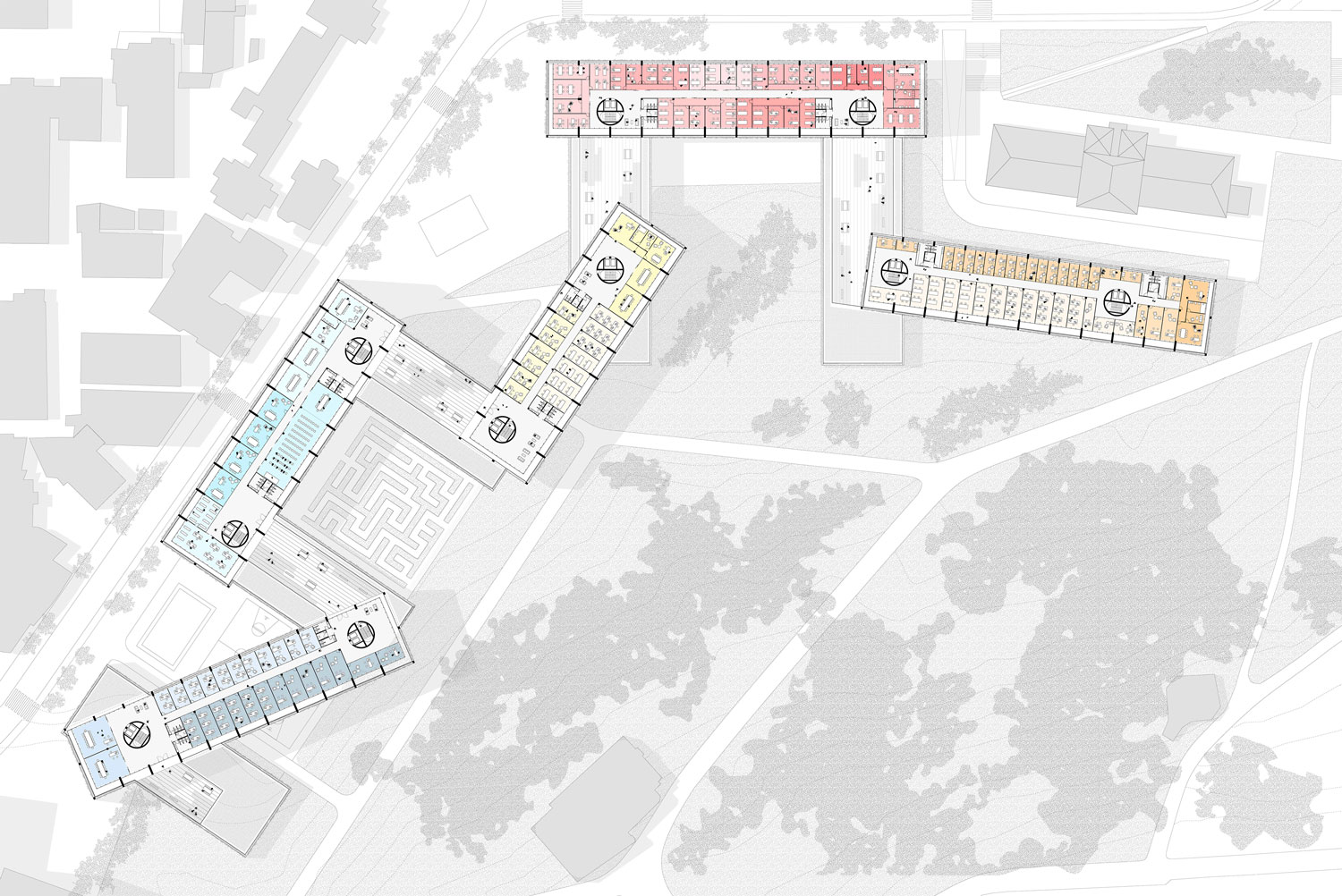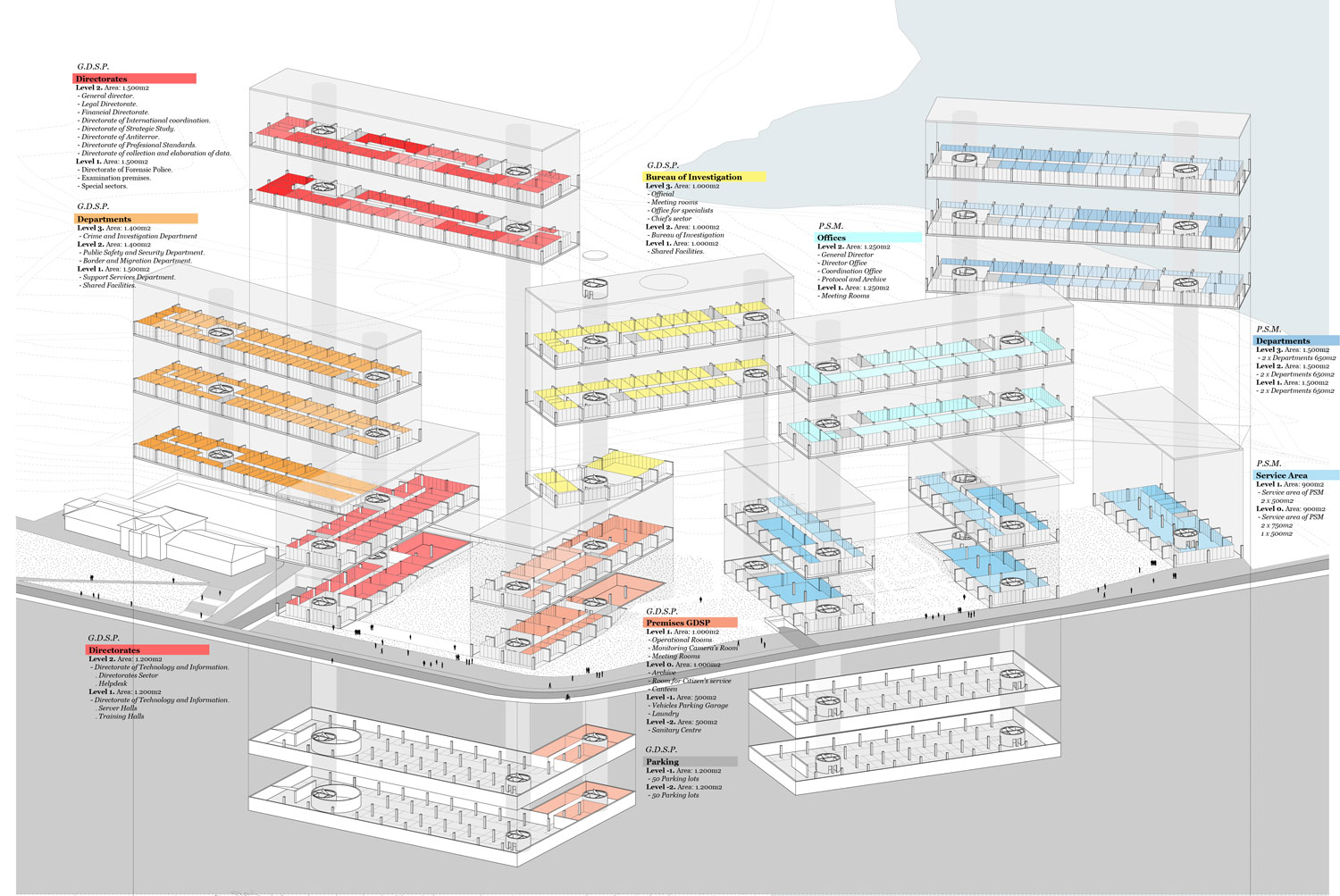1278-AZP-TIA.AL-2015
Client: Unknown
Status: Competition (2015)
Location: Tirana, Albania
Climate: Humid subtropical, Temperate
Materials: Concrete, Vegetal
Environments: Mountain, Urban
Visualizer: Studio
Scale: Large
Types: Administrative center, Institutional, Office, Office building
Our proposal for the municipal building complex that will define the Northern edge of the Tirana Park aims to move away from the need to monumentalize the two public institutions to be included in the complex, The Public Service Centre and the General Directorate of the State Police. On the contrary, our proposal is driven towards the construction of a new Northern Edge for Tirana’s Lake Park.
We see this operation more as a topographic structure that will define the edge of Lake Park and which should be more like a city wall or a river bank: a consistent structure that defines a condition of the edge between the Park and the City.
A Chain of Garden-Gates
Our building strategy is therefore structured around a continuous building pattern which produces a certain quality along the edge. Our idea is to produce a series of open courtyards/gardens which will provide a variety of green open spaces, intertwined with the fabric of the public buildings, which will mediate between the Park landscape and the city edge. Every one of the gardens will have a different quality: one would be a topiary labyrinth, another will be a sloped open-air auditorium, another will be a shaded garden with a sloping ground, another would be a rose garden… The easternmost one will enclose the Army Museum, which we propose to preserve as a historical remnant of the buildings existing on this site.
Every one of the gardens, which will be enclosed on three sides by the civic complex buildings are approximately 40m x 40m, a dimension that is extracted from the cortile of campuses and cloisters. The Diocletian Palace in Split, The Uffici in Florence, the Ospedale Maggiore in Milano, the Hospital de los Reyes Catolicos in Santiago or the Alhambra in Granada serve as precedents for a large-scale public institution which is served by a cluster of courtyards which allow to optimize ventilation, daylight and microclimate, while providing maximum flexibility of uses.
In the case of Tirana Lake Park, every cortile will be limited by two buildings on the ground which are located perpendicular to the park edge, and one building, sometimes located to the south or to the north of the garden, which bridging between the sides, two levels above ground, will form multiple gates, enabling people to cross through the courtyards, experiencing different gates associated to every garden.
For the complex to have maximum flexibility, we have connected the two institutions of the complex into a single structure, which is composed by a “universal” depth of 16m, which enables effective cross ventilation and daylight of all dependencies in the complex. In this way, the future use of the complex will not be determined by the current needs of Tirana, but will be allowed a much higher capacity to accommodate different administrative buildings.
A Mediterranean Fabric
Mediterranean villages are built as an accretion of very simple and effective building technologies: the consistency of the masonry walls and chalk would limit the height of construction, the length of available timber logs would determine the span of the bays. The scale of the windows would rely on the optimal scale of stone lintels… In our Tirana Civic Centre/Lake Park Gate, we have determined an efficient, cost effective, and sustainable unit, which has utmost versatility of use. A typical rectangular office plan, 16m wide and around 80m long, totaling around 1300m2 gross floor area of office spaces. Units of 2-3 such floors, around 2,500m2 and 3,800m2 appear as ideal quanta to host the required program, and future reorganizations of programs the Civic Complex may undergo in the future. These “Units” of administrative program are laid out on the ground, or bridge between them to form the Garden-Gates along the Park edge.
They are served by two separate underground parking structures to take into account the security required in the Police Administration, but could be linked in the future if the uses were to change.
The Units are to be built with low-carbon, pre-cast concrete, following an 8,1m x 8,1m grid, which will be both compatible with the parking structure and generic office layouts. The Units are to be built with low-carbon, recycled, locally sourced, precast concrete elements, although the bridge Units will incorporate large steel members. We have decided to use concrete because of the local availability of this material, and its thermal mass capacity, which makes it ideal to use in Mediterranean climates. The precast concrete structure will be easy to build and be compatible with the extensive planting which we propose to do in the buildings themselves, reminiscent of the vegetation of the buildings that is common in the Eastern Mediterranean villages: junipers, buxus, jasmin, clematis, parthenocissus, and many of the vegetation that can be found in traditional gardens in the Eastern Mediterranean will be literally covering the surfaces of the Units, whose roof will be entirely vegetated except for the introduction of a solar panels. All the South, East and West facades will be setback, leaving 2.1m terraces for systematic planting of the surfaces exposed to the sun with deciduous vegetation, which will be acting as sun-shading screens during the hot seasons while allowing sun penetration in the winter. A system of wooden ownings will be provided too in order to add a variable element of solar control to the buildings. The offices will otherwise have full double glazing units with wooden frames for efficient debridging.
We expect the buildings to be almost entirely covered in vegetation overtime, almost like old stone buildings overgrown with plants: an adequate texture for Tirana’s Lake Park Gate.
The programs for the General Directory of the State Police (G.D.S.P) and the Public Service Mall (P.S.M) have been distributed in the continuous Mediterranean fabric. The first two public courtyards to the East are embraced by the G.D.S.P premises, and the last two courtyards to the West are surrounded by the P.S.M spaces. The center courtyard acts as a hinge and mediates between both premises while opening the park towards the Rruga Vaso Pasha avenue.
In order to respond to the brief requirements, in the first 5 units to the East, the G.D.S.P offices have been located. 3 of these units sit in direct contact with the park while the other two, span over these three units connecting the different programmatic areas together.
The first unit to the East contains 3 floors of 1500 m2 to host the G.D.S.P Departments. At the pedestrian level, the department of the support services and the shared facilities have been located. At level 2, the public safety and security department border and migration department have been planned. Finally on the third floor, the crime and investigation department has been located.
The second unit to the East, inscribes the first courtyard surrounding the army museum. This unit has an area of 2000m2 and comprises 2 floors that host the premises of the G.D.S.P. At the pedestrian level, in close proximity to the army museum and the main access plaza of the park, the citizen service room, the library and the canteen have been located. On the second floor, the operational rooms, the monitoring camera’s room and the meeting rooms have been located. The access to the car-park also takes place adjacent to this unit. The G.D.S.P parking unfolds in two levels of 1200m2 and contains 100 parking lots.
In the third unit, in two storeys of 1200m2, the G.D.S.P directorate offices have been located. The directorate of technology and information, and the server and training halls have been located at the pedestrian level, while the sector of directorates sector and the helpdesk have been located in level 1.
The two units that rest over the described 3 units contain the remaining directorate offices and the bureau of investigation. The unit that contains the directorates has an area of 3000m2 and unfolds in two storeys. In the first level, the directorate of forensic police, the examination premises and the special sectors have been located. In the second level, the general director office, the legal directorate, the directorate of international coordination, the directorate of strategic study, the directorate of anti-terror, the directorate of professional standards and the directorate of collection and elaboration have been located.
The unit that contains the bureau of investigation acts as a hinge between the G.D.S.P and the P.S.M. The spaces of the bureau of investigation have been distributed in 3 levels of 1000m2. In the first level, the shared facilities have been placed. In level 2, the investigation rooms have been located. Finally in level 3, the official and meeting rooms, the offices for specialists and the chief’s sector have been located.
The P.S.M premises have been planned in the remaining 5 units located towards the West of the site. Following a similar volumetric configuration than that of the G.D.S.P, three units have been designed in direct contact with the park, while the other two span over these three units connecting the different programmatic areas together and framing 2 courtyards.
In the 3 units in direct contact with the park, comprising an area of 3000 m2, the service area has been located. Sitting over these volumes to the West, a unit of three floors and 3500m2 contains the P.S.M Departments, and to the East, a unit of 2 floors and 2500m2 hosts the main offices of the P.S.M. In level 1, the meeting Rooms and shared spaces have been placed, while in Level 2, the General Director and director’s office, the coordination area and the protocol and archive have been located.
There is an additional unit hosting public functions such as an info center and a ticket booth which doubles as a new viewing platform to the Mother Teresa square.
